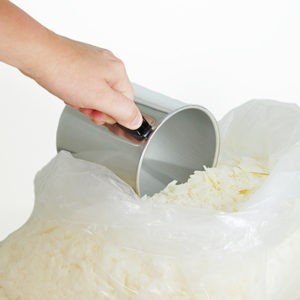Soy vs. Paraffin: The BIG Debate

We live in a world where consumers are paying much closer attention to what their bodies are exposed to both internally and externally. With the growing popularity of soy wax we receive a lot of phone calls and e-mails from customers who want to know the differences and benefits between soy and paraffin waxes. Unfortunately, there is a lot of bad information out on the internet regarding both paraffin and soy so we decided to set the record straight and provide our customers with the facts so that you can make a well-informed decision when choosing the wax that is right for you.
First, let's talk about these two waxes and how they are made before we get into the REAL debate.

Soy Wax
Soy waxes are made from soybean oil and can contain other non-soy materials. The soybean oil is separated from the beans by use of a mechanical press or by using a solvent to extract the oil. The primary step in making soy wax is a process called hydrogenation. Basically, the soybean oil is treated with a hydrogen solution that causes the oil to solidify and create wax. Every manufacturer has a different process and most of them keep their "recipes" very secretive but the process starts out the same for all of them.
Soy wax is a natural product that has these general properties:
- Non-Toxic - meaning that soy wax is not poisonous.
- Made of either 100% soybean oil or a combination of other non-soy materials (animal products and/or other vegetable products).
- Clean-burning fuel source - meaning soy wax meets several requirements under federal regulations that classify it as clean-burning.
- Colorless - meaning the wax itself does not contain any color and typically appears opaque.

Paraffin Wax
Paraffin waxes are actually petroleum-based and are created using crude oil (also known as fossil fuel) which is extracted from the earth. On a molecular level, crude oil is a mixture of hydrocarbons that were created from the decomposition of plants and animals that lived underwater many years ago. Once extracted, crude oil is sent to refineries where it is then turned into finished products like lubricating oil. It is from the lube oil refining process that paraffin waxes are created.
Paraffin wax is a natural product that has these general properties:
- Non-Toxic - meaning that paraffin wax is not poisonous.
- Non-Reactive - meaning that during certain lab tests, the wax did not respond or react to certain stimuli.
- Excellent water barrier - paraffin wax is very good at repelling water and other liquids.
- Clean-burning fuel source - meaning paraffin wax meets several requirements under federal regulations that classify it as clean-burning.
- Colorless - meaning the wax itself does not contain any color and typically appears semi-translucent.
So What's the Debate?
The biggest debate we see when it comes to paraffin wax is whether or not it is "bad" for you. You can find plenty of articles online talking about how paraffin wax releases "soot" into the air which is bad for you to breathe in. That statement is not exactly false, but it's not exactly true either. BOTH paraffin wax and soy wax can create soot depending on how the candle is made and how it is burning. While the soot is not good for your respiratory system it is, generally, not dangerous; it is the chemicals that the candle is emitting that may be hazardous to your health. Paraffin wax can produce certain emissions that can compromise the air quality in your home. These may include alkans, alkenes, and toluene which have all been reported to have harmful effects on humans. However, the amount of these chemicals that are being released into the air is so minimal that most people are not affected by them.
Contrary to popular belief, soy wax candles can emit chemicals into the air as well. Over 90% of soybean crops in the United States are genetically modified and are grown using pesticides. Some soy wax manufacturers process their soybean oil to filter out any genetically modified material as well as any "potentially present herbicides or pesticides" (source: www.ecosoyabrands.com). Not all soy wax manufacturers do this though which means a good portion of soy wax candles have the potential to emit chemicals into the air from herbicides and pesticides.
So now you might be thinking "Oh no! My paraffin and soy wax candles are toxic? What do I do now?" First of all, the waxes are not toxic. Both waxes have to pass a series of tests and meet certain standards that are monitored by the US government before they can be marketed as wax that is safe for use in candles. The key is...MODERATION. When it comes to your health, this is the rule for just about everything...medicine, junk food, alcohol, chocolate...all of these things are fine in moderation. If you burn your candles in a well-ventilated room, with a properly trimmed wick that doesn't kick up a lot of soot or smoke, chances are you will never see any negative effects on your health from candles. However, if you tend to be sensitive to things like perfumes or smoke you may have a reaction to candles burning in your home.
Scent Throw
We get a lot of phone calls from customers asking, "paraffin or soy...which is better for scent throw?" A lot of people think that the more fragrance oil a wax can hold, the stronger the scent throw will be. This isn't always true though because the type of wax you use has a lot to do with your scent throw. When you compare the scent throw of a paraffin candle to that of a soy candle, usually the scent throw is stronger in paraffin. Why? Well, on a molecular level, soy is denser than paraffin. Because soy is denser, it requires more heat to burn it up which can take longer for soy to release the fragrance. As the wax melts, the flame’s heat vaporizes the liquid wax which diffuses the fragrance oil into the air. So, if paraffin burns up easier, it will generally release the fragrance easier making the scent throw stronger or more prevalent.
Burn Time
There is a lot of question over which type of wax will give you a longer burn time. While there are several different factors that will affect a candle's burn time (wick size, additives in the wax, size of the candle, melting temperature of the wax, etc...) the type of wax you are using will affect your burn time as well. As previously stated, soy wax is more dense than paraffin and typically requires more heat to burn it up. This means that a soy wax candle would probably burn longer than a paraffin candle.
So, How do I Choose?
Now that you are informed about both soy and paraffin waxes, the choice is really up to you! There are benefits to using both types of waxes and it really all comes down to personal preference. If you decide that you want a clean-burning candle that will give you the strongest scent throw you can get, you might choose paraffin. If you want a wax that is clean-burning, comes from a renewable source, has a great scent throw, and burns longer, soy might be the way to go. Whether you choose soy or paraffin for your candles, you will be choosing a product that is safe to use, is responsibly made, and is perfect for YOU.